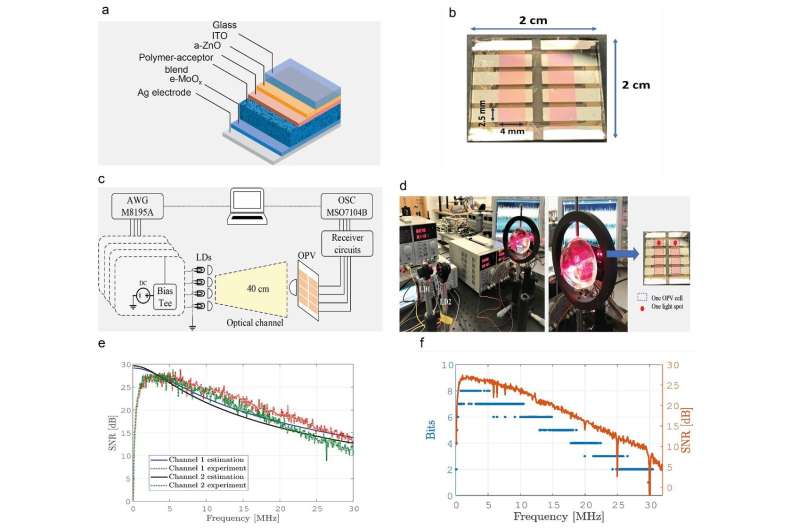a, Schematic of the OPV device architecture; b, fabricated OPV sample including eight individual cells and four common ground pads; c, block diagram of the multiple-input multiple output (MIMO) visible light data transmission system; d, experimental 2-by-2 MIMO setup with a single imaging lens; e, estimated and measured signal-to-noise ratio (SNR) of the two MIMO channels; f, adaptive bit loading applied to the orthogonal frequency division multiplexing (OFDM) data encoding scheme. The organic materials used in the OPV are PTB7-Th and EH-IDTBR. The subcarriers that exhibit the highest SNR are exposed to signals with up to 256 unique signal constellation points leading to the transmission of 8 (log2(256)) bits per transmission step. For comparison, on-off keying (OOK) would only allow one bit per transmission. In the 2-by-2 MIMO system, there are two independent channels and consequently, the maximum number of bits that can be transmitted per transmission step is 16 in the high SNR regions. Credit: Iman Tavakkolnia, Lethy K. Jagadamma, Rui Bian, Pavlos P. Manousiadis, Stefan Videv, Graham A. Turnbull, Ifor D. W. Samuel and Harald Haas
Around the world, there are currently more than 18 billion internet-connected mobile devices. In the next 10 years, anticipated growth in the internet of Things (IoT) and in machine-type communication in general, will lead to a world of hundreds of billions of data-connected objects. Such growth poses two very challenging problems:
- Securely connecting many wireless devices to the internet as radio-frequency bandwidth becomes scarce
- Powering all these devices
Regular, manual charging of all mobile internet-connected devices will not be feasible, and connection to the power grid cannot be generally assumed. Therefore, many of these mobile devices will need to be able to harvest energy to become largely energy autonomous.
In a new paper published in Light: Science & Applications, researchers from the University of Strathclyde and the University of St. Andrews have demonstrated a plastic solar panel that combines indoor optical energy harvesting with simultaneously receiving multiple high-speed data signals by multiple-input/multiple-output (MIMO) visible light communications (VLC).
The research, led by Professor Harald Haas from the Strathclyde LiFi Research and Development Centre, and Professors Ifor Samuel and Graham Turnbull at the St. Andrews Organic Semiconductor Centre, makes an important step towards the future realization of self-powered, data-connected devices.
The research teams showed that organic photovoltaics (OPVs), solar cells made from similar plastic-like materials to those used in OLED smartphone displays, are suitable for high-speed optical data receivers that can also harvest power. Using an optimized combination of organic semiconductor materials, stable OPVs were designed and fabricated for efficient power conversion of indoor lighting. A panel of 4 OPV cells was then used in an optical wireless communication experiment, receiving a data rate of 363 Mb/s from an array of 4 laser diodes (each laser transmitting a separate signal), while simultaneously harvesting 11 mW of optical power.
Prof Turnbull explained: "Organic photovoltaics offers an excellent platform for indoor power harvesting for mobile devices. Their advantage over silicon is that the materials can be designed to achieve maximum quantum efficiency for typical LED lighting wavelengths. Combined with the data reception capability, this opens up a significant opportunity for self-powered internet of Things devices."
Prof Haas said, "Organic photovoltaic cells are very attractive because they are easily made and can be flexible, allowing mass integration into internet-connected devices. In addition, compared to inorganic detectors, OPVs have the potential to be significantly cheaper, which is a key driver to their large-scale commercial adoption.
"Visible light communication provides unregulated, vast resources to alleviate emerging wireless capacity bottlenecks. Of course, visible light can also provide energy. To achieve both objectives with a single device, new solar cells are needed. They must be capable of simultaneously harvesting energy and detecting data at high speeds. It is therefore essential to develop solar cells that have two key features: (a) they exhibit a very large electrical bandwidth in the photovoltaic mode of operation, and (b) have a large collection area to be able to collect a sufficient number of photons to achieve high signal-to-noise ratio (SNR) and harvest maximum energy from light.
"The two requirements are typically mutually exclusive because a large detector area results in a high capacitance and hence low electrical bandwidth. In this research, we have overcome this fundamental limitation by using an array of OPV cells as a MIMO receiver to establish multiple parallel and independent data channels while being able to accumulate the harvested energies of all individual solar cells. To the best of our knowledge, this has never been shown before. This work therefore lays the foundation for the creation of a very large, massive MIMO solar cell receiver enabling hundreds and potentially thousands of individual data streams while using the huge collection area to harvest large amounts of energy from light (both data carrying and ambient light). It is imaginable to turn entire walls into a gigabit per second data detector while harvesting sufficient energy to power many distributed intelligent sensors, data processing and communication nodes."
More information: Iman Tavakkolnia et al, Organic photovoltaics for simultaneous energy harvesting and high-speed MIMO optical wireless communications, Light: Science & Applications (2021). DOI: 10.1038/s41377-021-00487-9
Journal information: Light: Science & Applications
Provided by Chinese Academy of Sciences
























